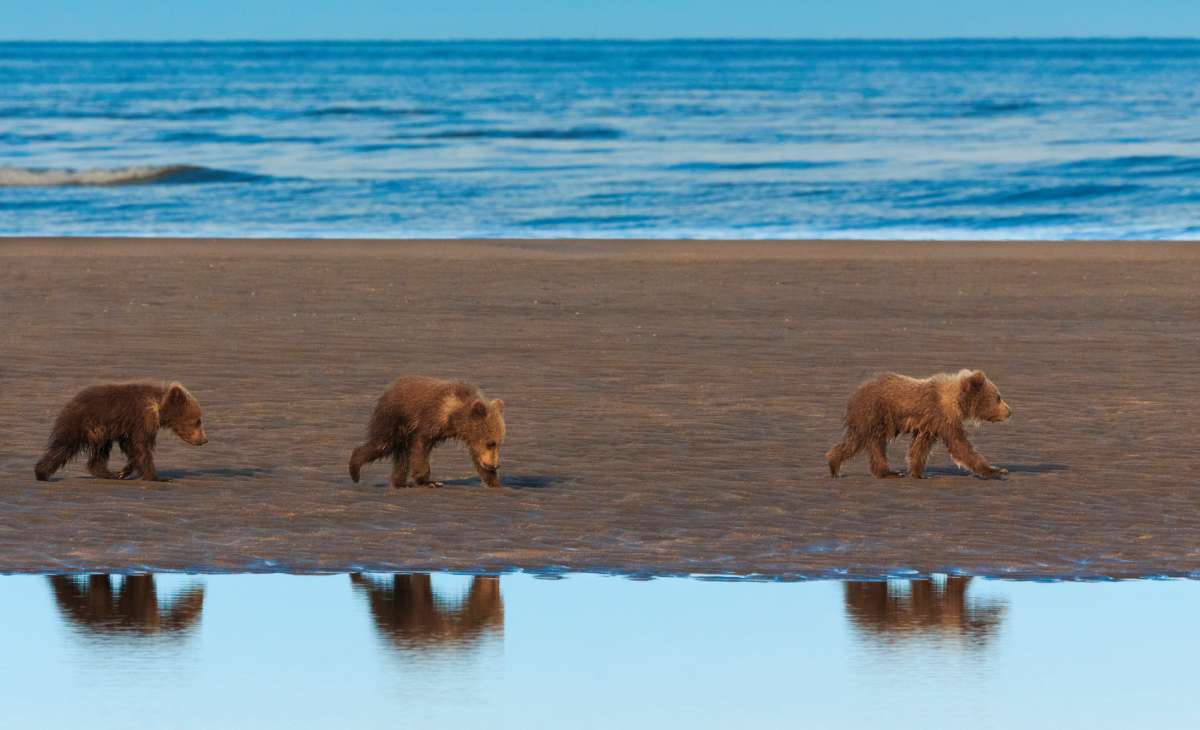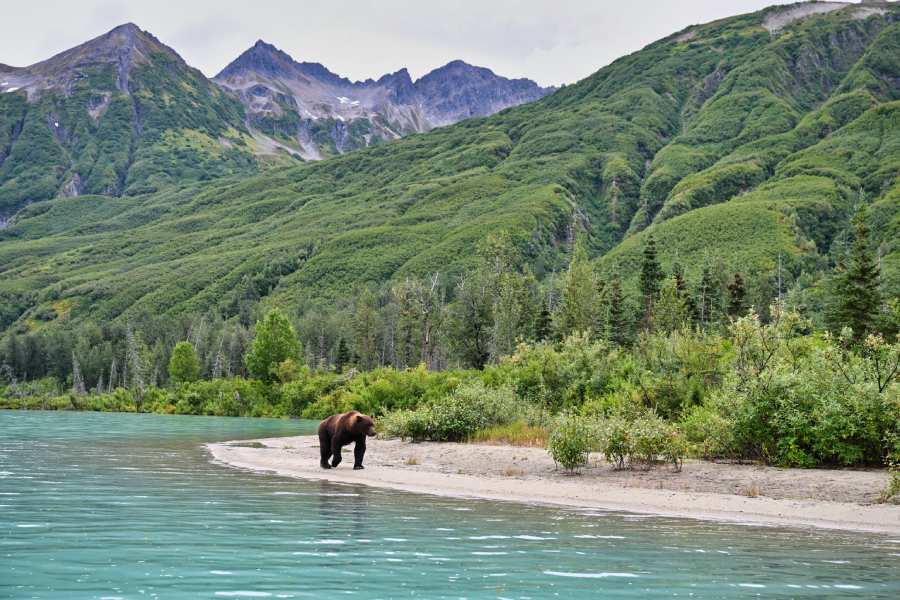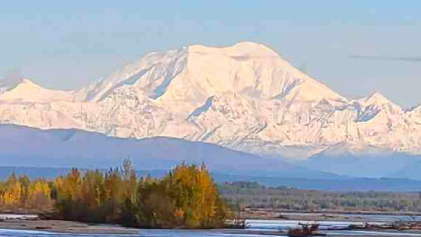Let's Go Bear Viewing At Lake Clark!
Download Travel Details >PRIVATE & SMALL GROUP TOURS TO THE WORLD'S BEST DESTINATIONS
Three Amazing Alaskan Vacations To Choose From!

Bear Viewing Lake Clark
 Lake Clark National Park and Preserve offers visitors world-class bear viewing opportunities on the beautiful coast of Alaska, where brown bears congregate in high numbers to feast on protein-rich sedges, clams, and salmon found in the area. Bear Viewing at Lake Clark may be a little tricky to get to - you have to fly in by floatplane - but the spectacular bear viewing is worth the flight!
Lake Clark National Park and Preserve offers visitors world-class bear viewing opportunities on the beautiful coast of Alaska, where brown bears congregate in high numbers to feast on protein-rich sedges, clams, and salmon found in the area. Bear Viewing at Lake Clark may be a little tricky to get to - you have to fly in by floatplane - but the spectacular bear viewing is worth the flight!
You may be wondering if there is more than one spot to go bear viewing at Lake Clark. Well, you're in luck - there is. Lake Clark National Park in Alaska offers multiple locations for bear viewing, providing visitors with a diverse range of opportunities to observe these majestic creatures in their natural habitat. Here is where you can see the bears if you go bear viewing at Lake Clark National Park and Preserve:
- Chinitna Bay - located at the southern end of the park on the Cook Inlet Coast, Chinitna Bay offers world-class bear viewing. Visitors can see as many as 20 coastal brown bears together in one location during their visit!
- Crescent Lake - this lake, nestled in the heart of the Chigmit Mountains, is a sports fisherman's dream. But during the salmon run, the brown and black bears are the only fishermen on the lake.
- Silver Salmon Creek - located on Cook Inlet, this area offers visitors the chance to watch bears and/or take part in some serious sport fishing. The breathtaking natural beauty of the surrounding mountains and forests adds to the allure of this pristine wilderness destination.
- Shelter Creek and Tuxedni Bay - both areas provide a rich bear habitat and fantastic bear viewing, but they are more difficult to reach and less frequently visited by people. (Use extreme caution if visiting this area. Bears are not used to human visitors, and are less likely to tolerate interactions.)
What Is Lake Clark National Park and Preserve?
Lake Clark National Park and Preserve was established in 1980 as part of the Alaska National Interest Lands Conservation Act because it was in the national interest to protect the unique Lake Clark Bear Viewing Habitat! The homesteaders who lived inside the boundaries of the park when it was created got to keep their land and even a few special "inholdings" of private land within the park. They were allowed to continue living on their properties, maintaining a unique balance between private ownership and conservation efforts within the park.
The area of the park is 4,094 square miles, and that of the preserve is an additional 2,204 square miles. Boreal forests of spruce, birch, and poplar are found at lower elevations in the part, while the hills of the interior are covered by tundra vegetation. The park's wildlife included caribou, Dall sheep, Alaska brown and black bears, bald eagles, and peregrine falcons. In addition to sockeye salmon, other species of salmon and fish such as trout and grayling inhabit the lakes and streams of the park and preserve.
Bear viewing at Lake Clark is one of the area's top attractions, but Alaska is full of bear viewing opportunities. From the coastal regions to the inland wilderness, encounters with these magnificent creatures are an unforgettable experience in the Last Frontier. Where else can you watch these magnificent creatures in their natural habitat? Read on to find out more!

Brooks Lodge Alaska Bear Viewing
If you schedule a Katmai National Park bear viewing tour, book a night (or two) at Brooks Lodge! This is the only full-service lodge within walking distance from Brooks Falls, which may be Alaska's most celebrated destination to watch Alaskan brown bears fish for salmon during the summer months. As many as 50 bears live along the mile-and-a-half-long Brooks River during the salmon season, many of which can be observed from three elevated viewing platforms built along the river for Brooks Lodge Alaska Bear Viewing.
Brooks Falls is located in Katmai National Park and Preserve, which boasts the largest population of brown bears in the world. The bears frequent the falls during the salmon run, providing a spectacular opportunity for visitors to witness these majestic creatures in their natural habitat. If you book a Brooks Lodge Alaska Bear Viewing tour, odds are you will see a bear within minutes of your arrival. There are just that many opportunities to see bears in this park!
One of the most amazing things to see during a Brooks Falls Alaska Bear Viewing tour is the bears in action. Did you know there are many styles of fishing, and that each bear puts his signature spin on the hunt? Read on for more details:
Bear Fishing Style #1 - Stand and Wait
This refers to the bears who stand on top of Brooks Falls and wait for sockeye salmon to jump close enough to catch in their mouths. This fishing technique is used by adult bears that can defend this fishing spot, but it is also used by some younger bears when space is available. This is a good technique to use when many salmon are jumping at Brooks Falls.
Bear Fishing Style #2 - Sit and Wait
Bears will sit just underneath Brooks Falls in several places, like the plunge pool or “jacuzzi,” and wait for salmon to swim to them. When they feel a fish in the water, they quickly pin it to the stream bottom or against their body with their paws, bite it, and begin to eat.
Bear Fishing Style #3 - Dash and Grab
Bears often chase fish and attempt to pin them to the river bottom with their paws. This technique is commonly employed early in the salmon run, but because it is energetically costly, it is quickly abandoned when the salmon run begins to thin.
Bear Fishing Style #4 - Snorkeling
This technique is used almost universally by bears throughout the summer and refers to bears that look for fish under the water.
Bear Fishing Style #5 - Pirating
Pirating is when a bear steals fish from other bears. Pirating is more common early in the salmon run but is not often observed in September or October. The threat of piracy will cause certain bears (like smaller subadults) to run with their fish away from the river and into the forest, where they are less likely to have their fish stolen.
Bear Fishing Style #6 - Diving
This is a fishing technique that most bears do not use and refers to a bear completely submerging itself in search of a fish. Diving is used more frequently in the fall, with dead salmon littering the river bottom.
Bear Fishing Style #7 - Begging
Bears do not share food with other bears, but some bears will still beg from others. This interaction occurs between bears that are highly tolerant of each other. Begging bears approach another (usually more dominant) bear-eating fish and position themselves inches away from the other bear. If a begging bear gets any fish, it is usually leftover scraps that the other bear doesn’t want. Begging bears often vocalize loudly, making a noise that sounds like a bawling cub. Begging is not a common behavior.
Don't Hesitate - Book Your Bear Viewing Tour Today
It doesn't matter if you go bear viewing at Lake Clark or book a Brooks Lodge Alaska Bear Viewing tour/Katmai National Park Bear Viewing tour, you are sure to be delighted by the experience of seeing bears in their natural habitat, especially during a salmon run. Make sure to schedule a Katmai National Park Bear Viewing Tour, a Brooks Lodge Alaska Bear Viewing trip, or bear viewing at Lake Clark before the season sells out! Don't miss the chance to witness these majestic creatures in their natural habitat and create unforgettable memories that will last a lifetime.


